Reviews
At the Met Breuer, Awe-Inspiring Sculptures of Deities Show How an Indian Artist Forged Her Own Personal Language for Fabric Art
Long misunderstood, Mrinalini Mukherjee gets her due in New York.
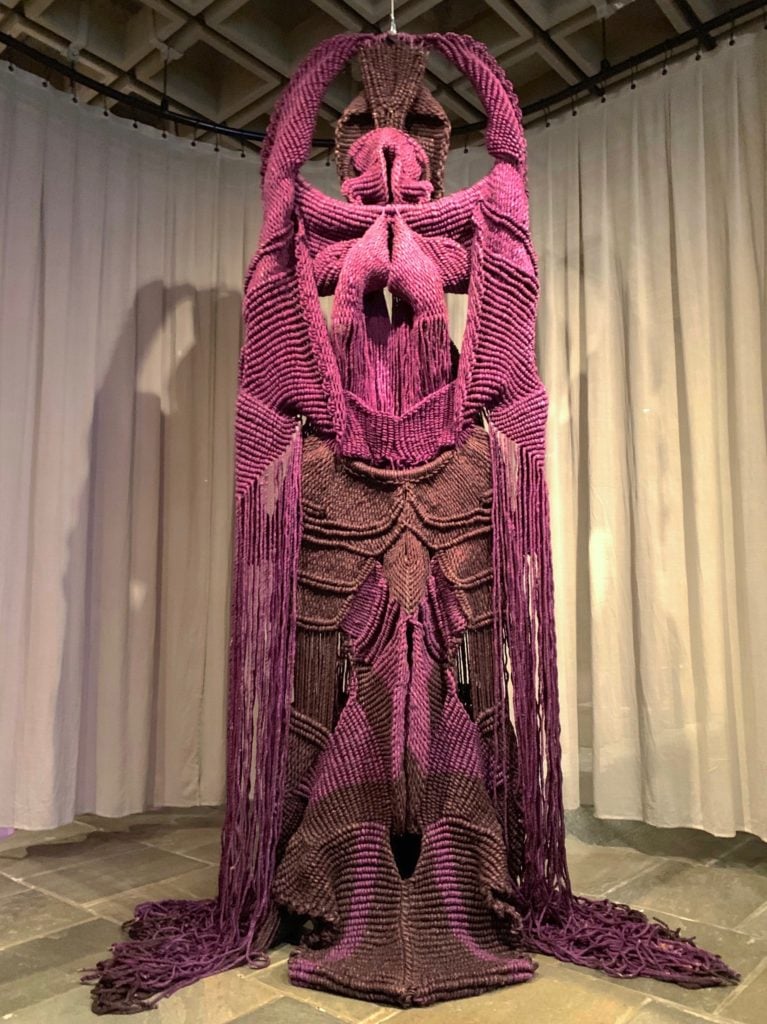
Long misunderstood, Mrinalini Mukherjee gets her due in New York.

Ben Davis

My sense is that the public might be in danger of missing the Mrinalini Mukherjee show, “Phenomenal Nature,” which opened recently at New York’s Met Breuer, because her name is not well known, and because it lacks an easy hook. Mukherjee hailed from a different art world, India in the 1970s to the 2000s, and her work draws on a pool of references and traditions that might be slightly unfamiliar. But at the same time, her sculptures eschewed the kinds of easily marketed images of “Indian-ness” that the global contemporary art biz sometimes feeds on. It has its own rhythms, and you can’t approach it either purely formally or purely iconographically, but have to find some other way in.
The sense of falling between two stools was very much something that Mukherjee herself felt. The Indian art critic Geeta Kapur remembers the sculptor asking her, in a way “both perplexed and provocative,” about the reception of her art: “People say I am a modernist but not contemporary—so, Geeta, what does it mean?” More than that, the slightly unplaceable place that the work inhabits is due to the fact that Mukherjee really was doing the labor of staking out new terrain, navigating the psychic dilemmas of art-making in post-colonial India.
Mukherjee experienced acclaim in her life, but died just before her full career got its big celebration in the show “Transfigurations: The Sculpture of Mrinalini Mukherjee” at the National Gallery of Modern Art in New Delhi, in 2015. She was born in Mumbai to artist parents, and would go on to count as mentors both teacher and artist K.G. Subramanyan and painter Jagdish Swaminathan, major theorists in setting the course for Indian art. In New Delhi, she was part of a vibrant creative community of designers, architects, and artists, but she also would study at the West Surrey College of Art and Design, through a British Council scholarship, at the end of the ’70s.
Pictured above is Rudra (Deity of Terror) (1982). The towering purple form looms about halfway through the Met survey, the largest of her knotted sculptures in the show, suspended from the ceiling to appear to be rising up from the ground. It is part of a cluster of large works, each in a different color, each distinctly anthropomorphic but not exactly resolvable into an obvious figure. They are all full of folds and cavities and protuberances that suggest alternately limbs or genitals or the features of a giant mask, or the abstracted ornaments of a ritual costume.

Left to right: Mrinalini Mukherjee’s Basanti (She of Spring) (1984), Yakshi (Female Forest deity) (1984), Pakshi (Bird) (1985), Rudra (Deity of Terror) (1982), and Devi (Goddess) (1982). Image: Ben Davis.
Given that Mukherjee was born right after India gained independence from Britain, her art had to navigate a sometimes tense and confusing conversation about the role of the artist. Did Indian artists dig back into local tradition, reclaiming the value of cultures degraded by a century of foreign domination, or did they claim the language of individual expression, formalism, and the “modern,” defining their own, Indian version of it? Or was that a false choice?
Mukherjee’s decision to devote herself, at the beginning of her career, to making art from masses of knotted rope may seem to resonate with the reclamation of craft and textile arts that was taking place among feminist artists in the US in the same period—but that’s a false cognate. Her own painstaking knotted accumulations were meant to chime with India’s tradition of village textile arts, evoking a grounding in popular aesthetics.
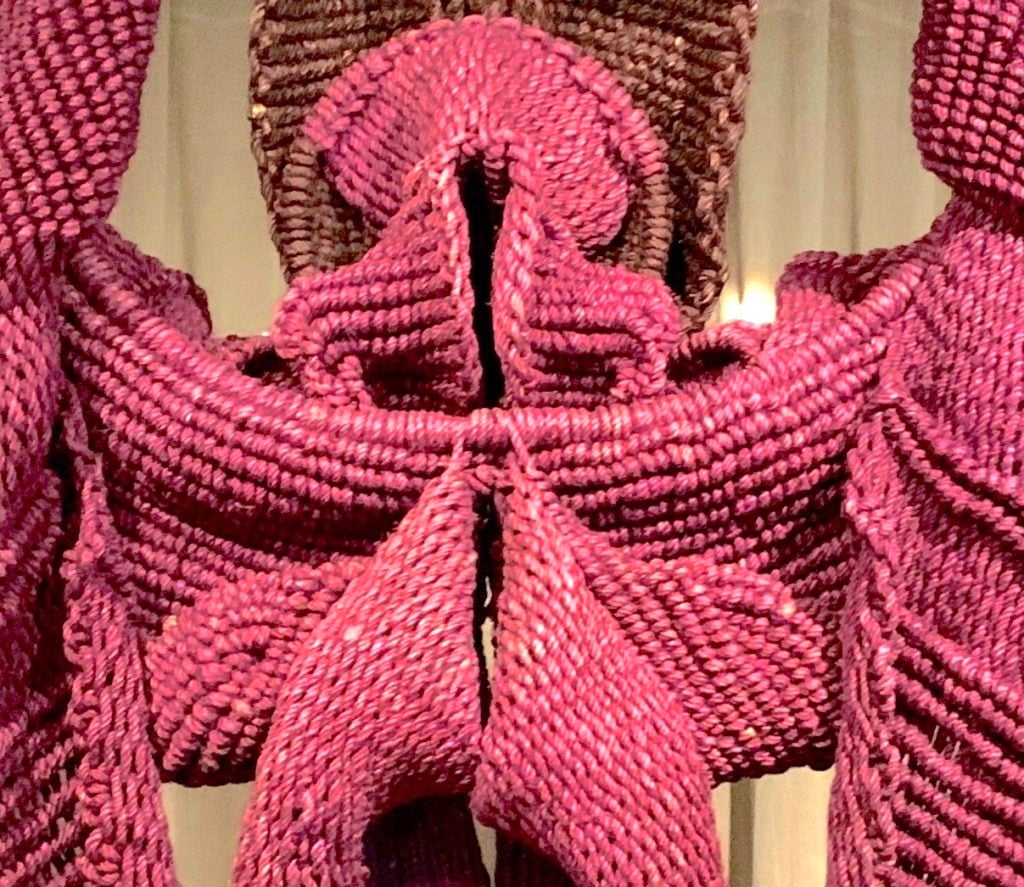
Detail of Mrinalini Mukherjee’s Rudra (Deity of Terror) (1982). Photo: Ben Davis.
Yet this impulse was also balanced with a drive to be experimentally of-the-present: Mukherjee used modern chemical dyes, not natural ones, to get the precisely controlled color effects that she wanted. More importantly, since no one else in her milieu was making the kind of soft sculpture that she was, this particular choice of medium allowed her to define an autographic artistic personality.
Rudra is the name of a Vedic storm god, associated with Shiva, the destroyer. Yet while it may refer to the “Deity of Terror” of the work’s title, the sculpture doesn’t convey terror to me. The enigmatic features more suggest a sense of inscrutable awesomeness, slightly beyond being pinned down in a solid representation, let alone a solid emotional tone.
Mukherjee’s use of textiles accentuates this sense. Her tightly knotted hemp forms involve a painstaking, ultimately impossible attempt to wrestle forth a form—it is just not the most exact medium (in general, the more closely her sculptures start to try to suggest definable features, human or otherwise, the less convincing they are). Her towering figures have an intricate ornamental symmetry, but the play of the pliable material makes it so that the forms never truly rest in any achieved balance. The matter from which the image is being conjured remains intransigent.
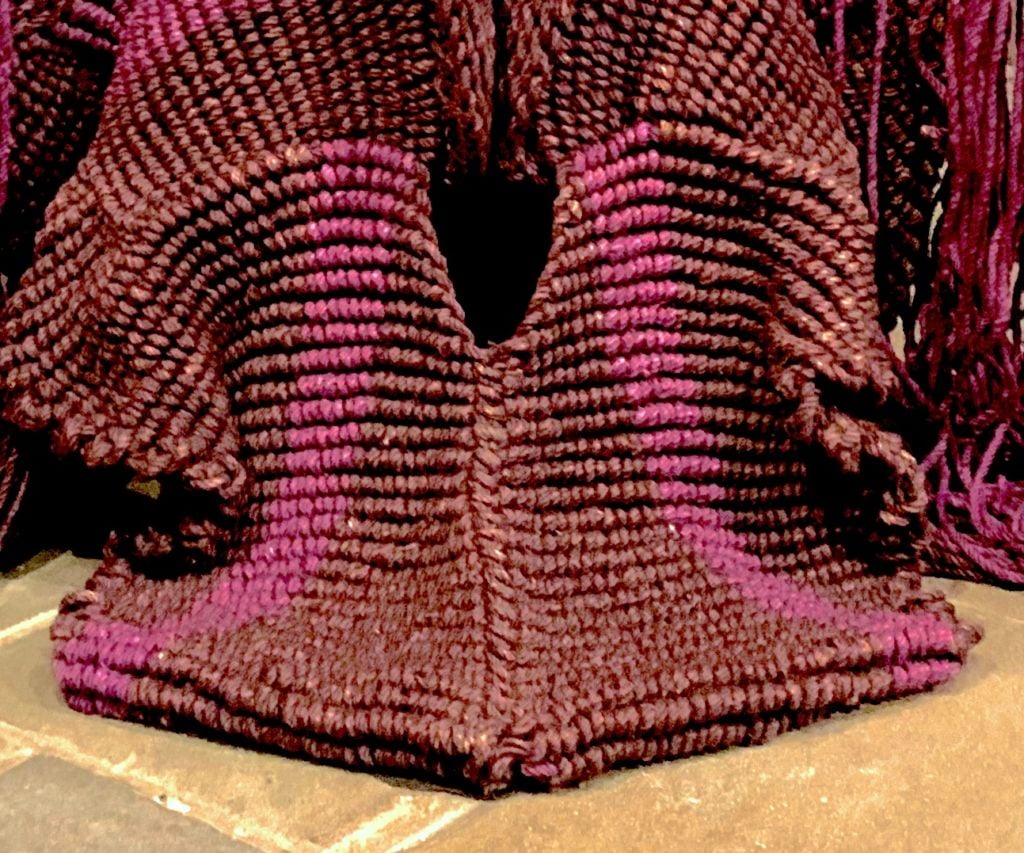
Detail of Mrinalini Mukherjee’s Rudra (Deity of Terror) (1982). Photo: Ben Davis.
When, in 1994, a group of Mukherjee’s works suggesting deities and nature spirits went on view at the Museum of Modern Art, Oxford, the temptation of British critics and observers was to assume that the artist was directly illustrating her own spiritual beliefs. At the same time, back home, critic M. Ramachandan would slam Mukherjee for catering to a Western taste that associated India with the mystical and the sensual.
Mukherjee held her own. Defending her artistic intentions, she was pretty clear about the nature of her subject matter, stressing that she was neither “a practicing Hindu,” nor had her parents been particularly devout. “[M]y mythology is de-conventionalized and personal, as indeed are my methods and materials,” she said. “My idea of the sacred is not rooted in any specific culture.”
In the second half of her career, Mukherjee would turn to ceramics and then bronze, evoking imaginary forms of plant life, moving away from the specifically mythical evocations of this stage of her career (some of the loveliest works in “Phenomenal Nature” are her late, quietly confident Palmscapes). This transition was partly due to practical concerns—the kind of fiber she worked with became hard to find—even as the turn in subject matter also sidestepped the headaches that the mythical allusions had given her, both at home and abroad.
But it is finally worth remembering that a work like Rudra (Deity of Terror) reflects a novel compromise between formal abstraction and a more traditional iconography of devotion. It is not really a representation of a Vedic deity. But nor does its abstraction represent modern alienation from the subject matter—that is, how an artist in the present can only consider such imagery as an empty shell, a dead form to pastiche, a ruin.
A work like Rudra seems instead to stand for another use of abstraction altogether, one connected to the more generalized and syncretic sense of “the sacred” that the artist spoke of. With its radiating patterns, towering presence, and strangeness of form, it evokes the sense of a larger wildness of the world—both spiritual and natural, both connecting with humanity but larger than it—that a mythology of specific gods and spirits coalesces out of in the first place.
See more images from “Phenomenal Nature” below.
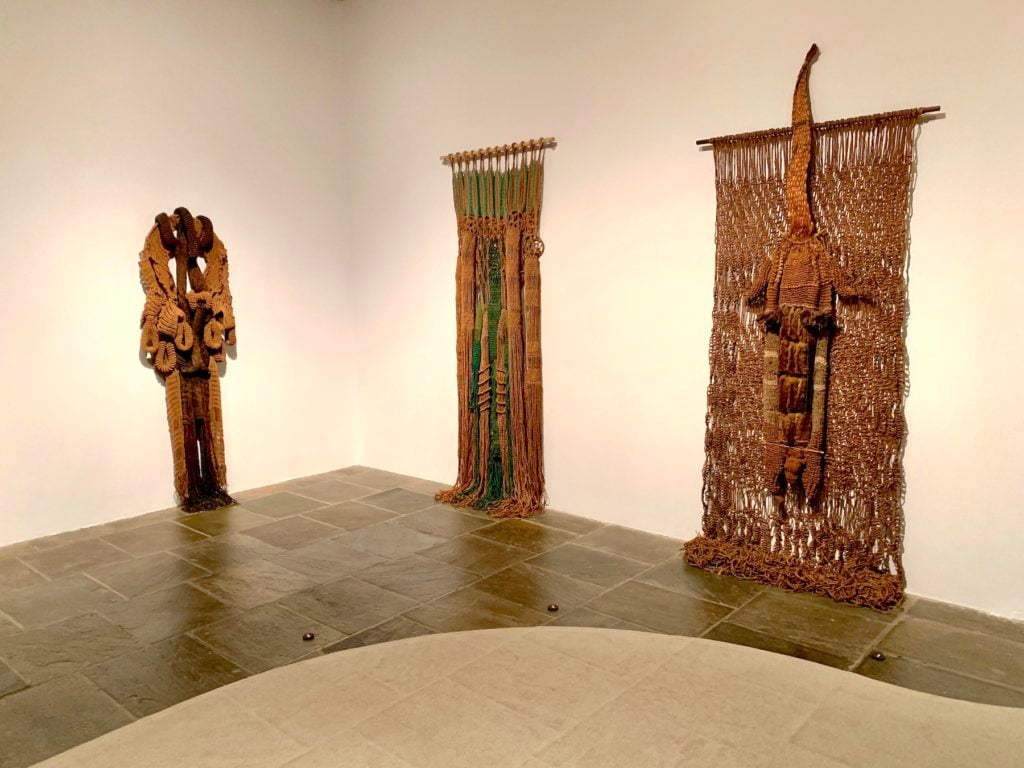
Left to right: Mrinalini Mukherjee’s Black Formation (1977), Waterfall (1975), and Squirrel (1972). Image: Ben Davis.
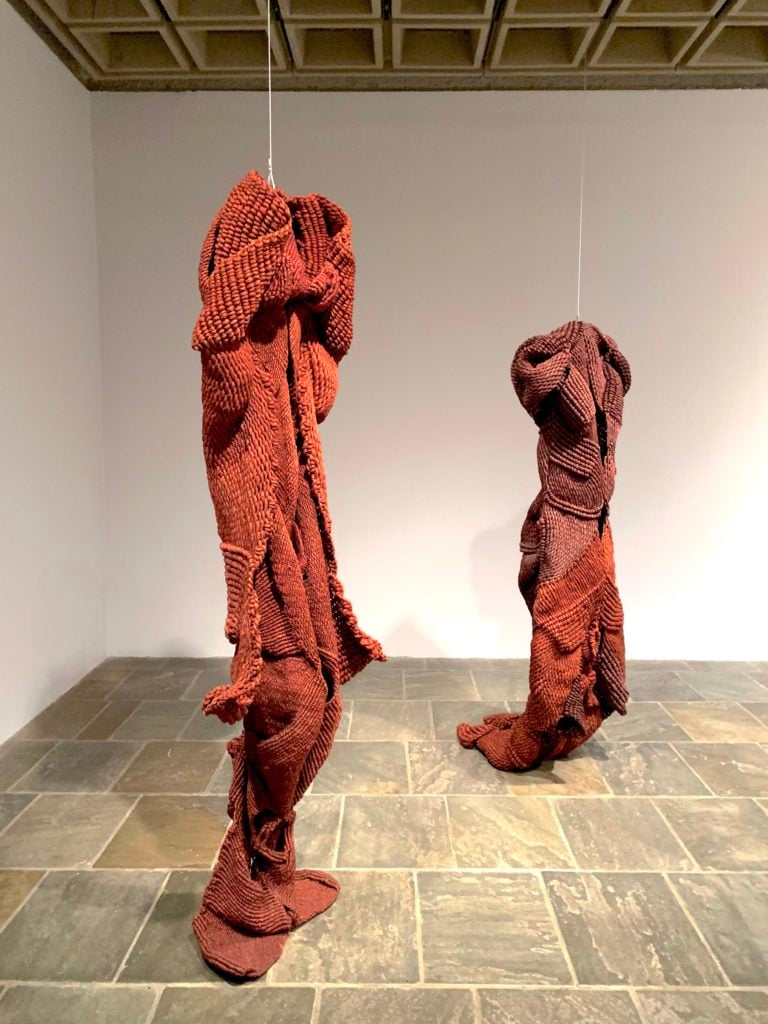
Left to right: Mrinalini Mukherjee’s Pari (Nymph) (1986) and Yogini (Female Seeker) (1986). Image: Ben Davis.
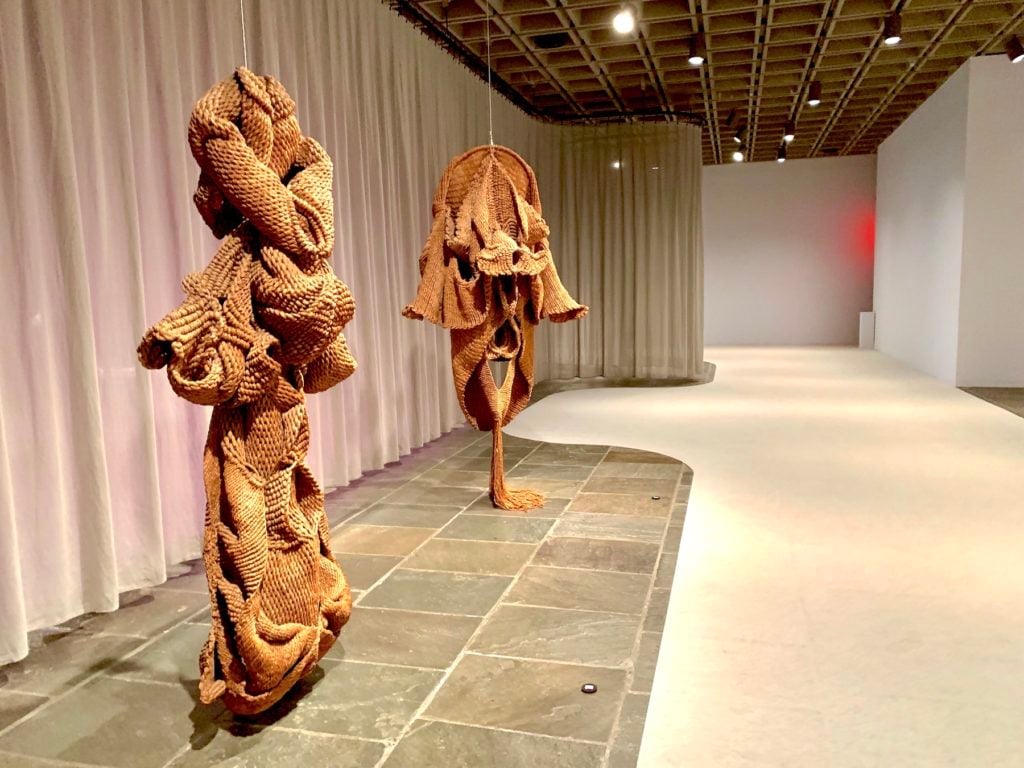
Left to right: Mrinalini Mukherjee’s Apsara (Celestial Nymph) (1985) and Sri (Deity) (1982). Image: Ben Davis.
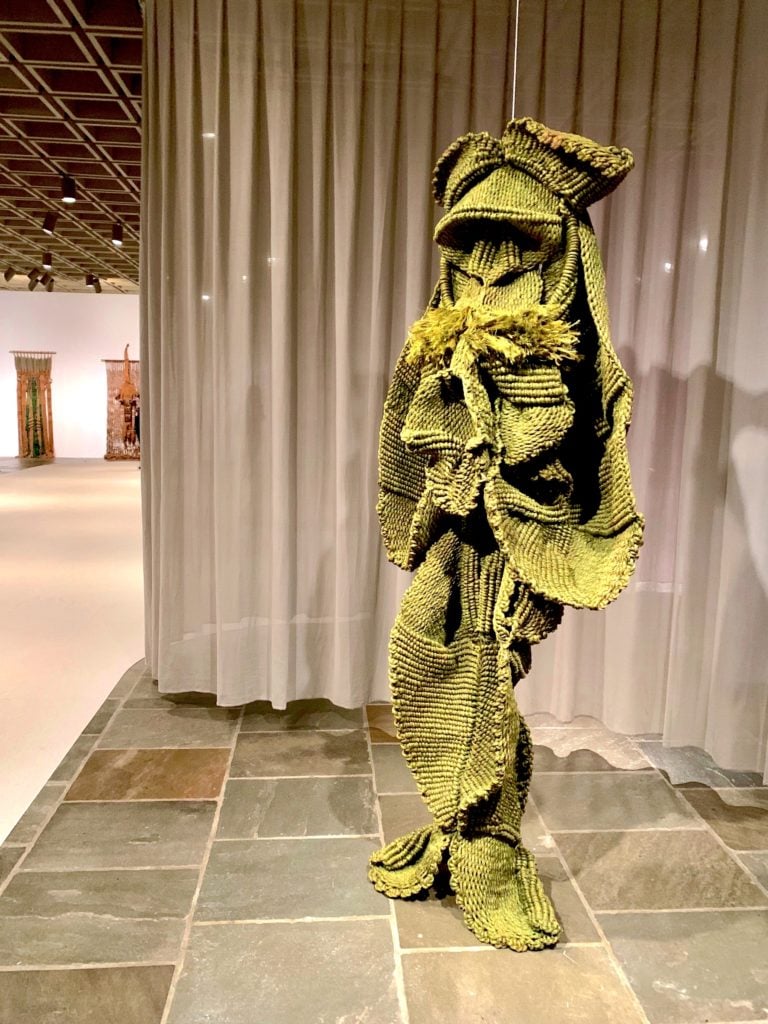
Mrinalini Mukherjee, Van Raja I (1981). Image: Ben Davis.
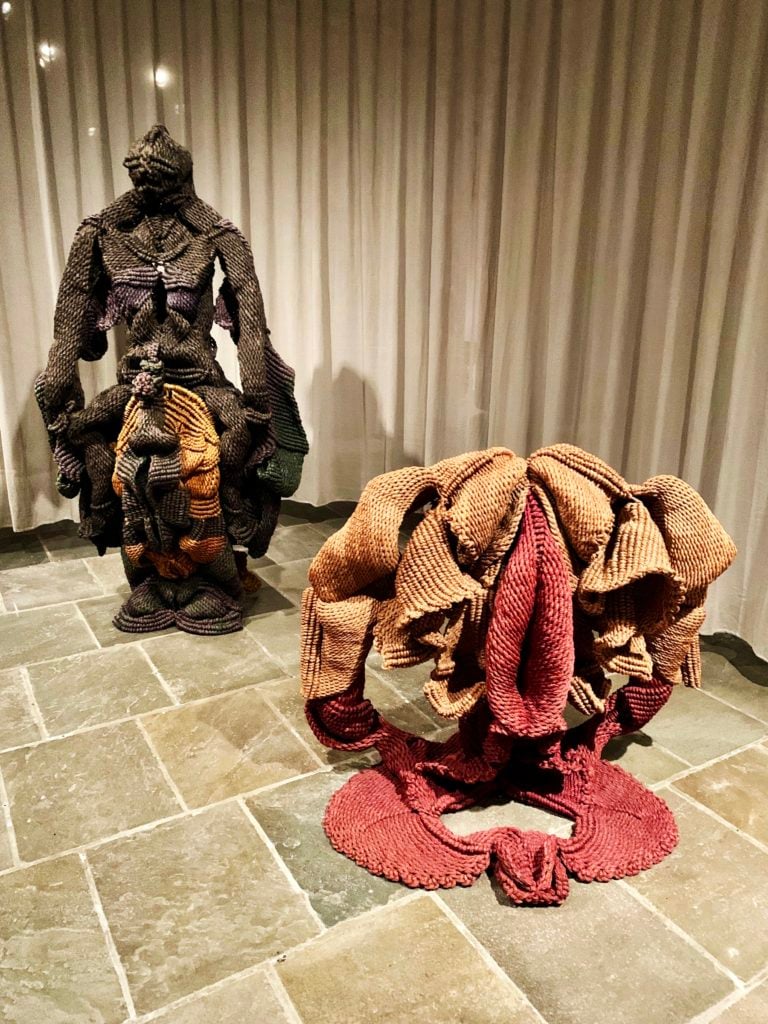
Left to right: Mrinalini Mukherjee’s Woman on Peacock (1991) and Pushp (Flower) (1993). Image: Ben Davis.
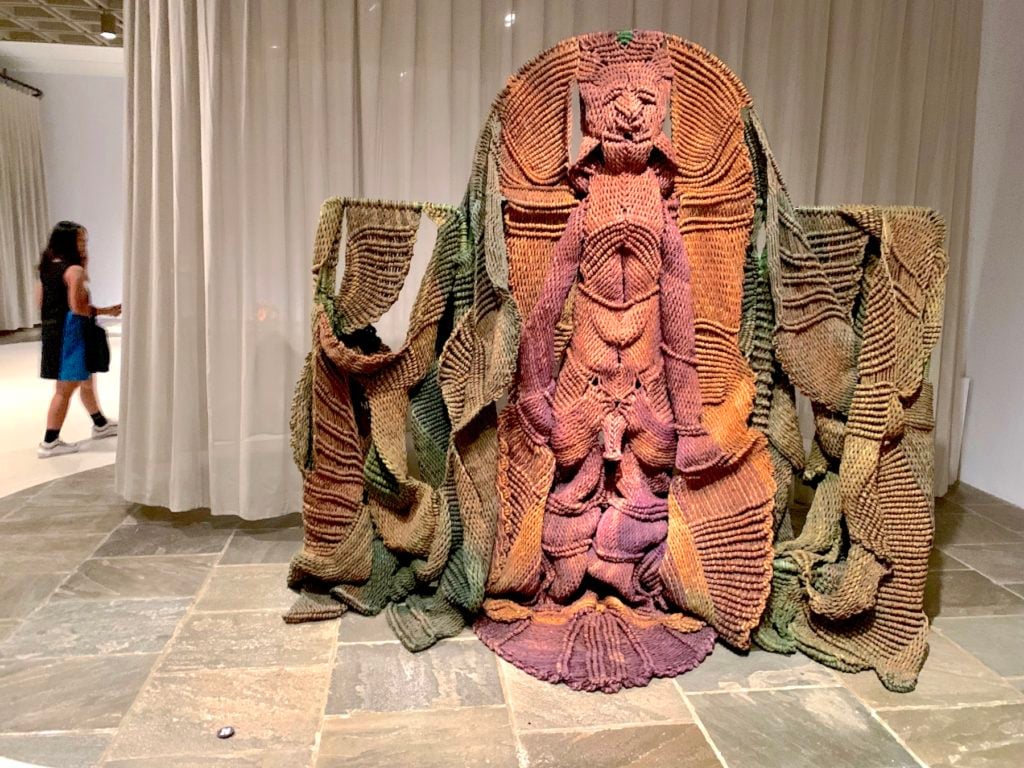
Mrinalini Mukherjee, Van Raja II (King of the Forest) (1991-94). Image: Ben Davis.
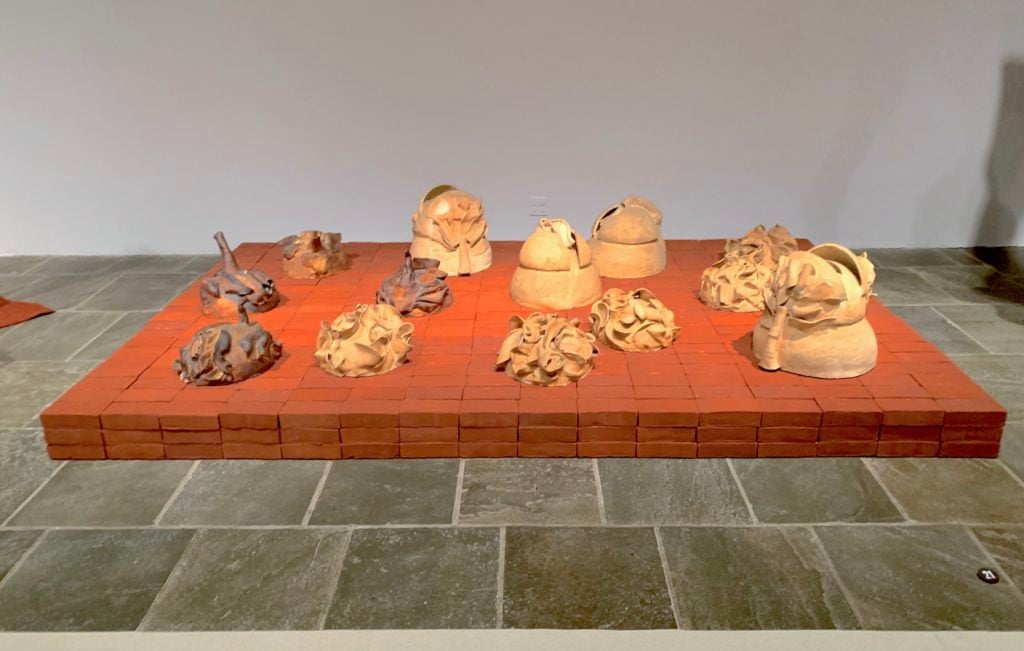
Mrinalini Mukherjee, Lotus Pond (1995). Image: Ben Davis.
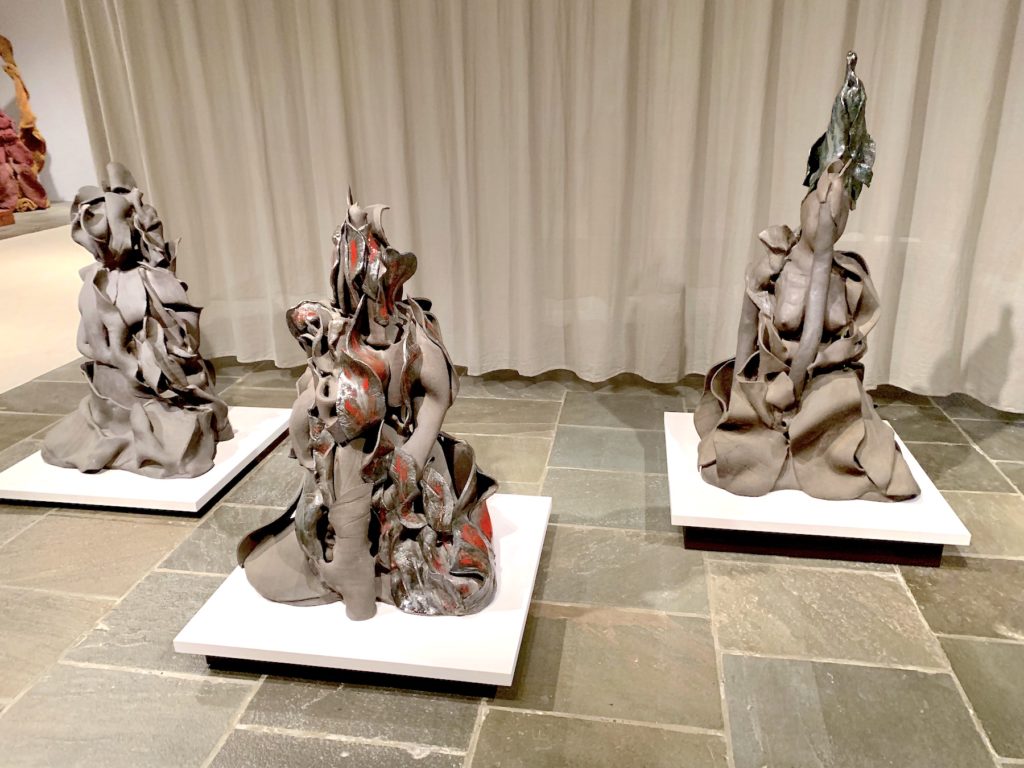
Left to right: Mrinalini Mukherjee’s Night Bloom I (1999-2000), Night Bloom II, and Night Bloom III. Image: Ben Davis.
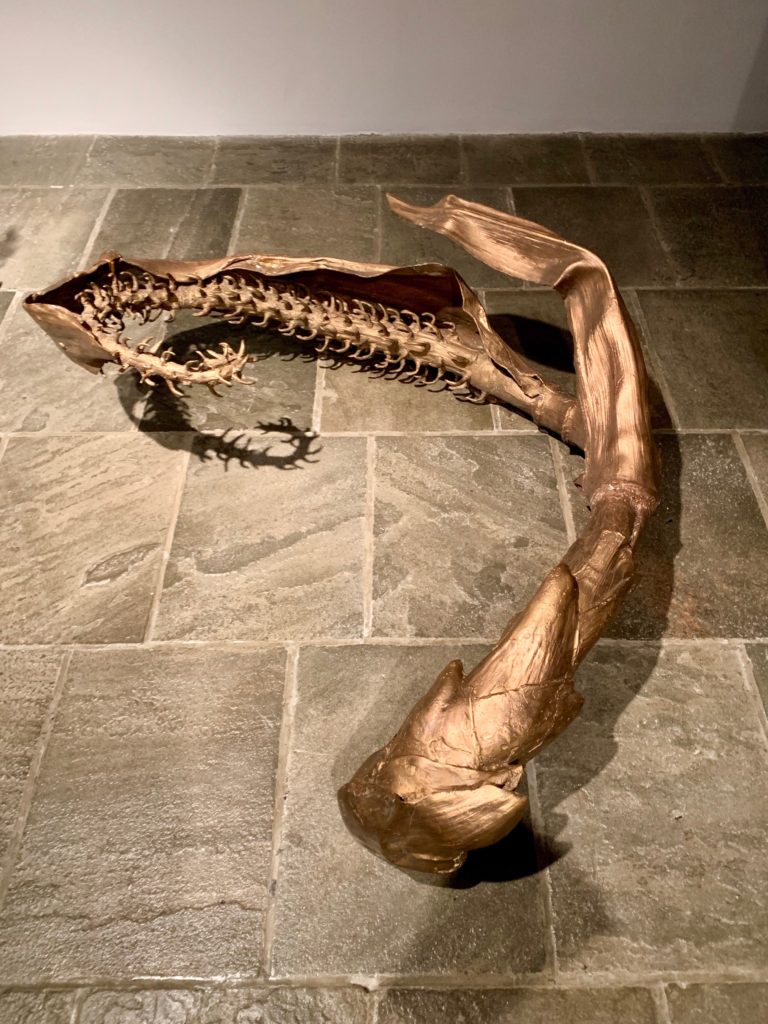
Mrinalini Mukherjee, Palmscape I (2013). Image: Ben Davis.
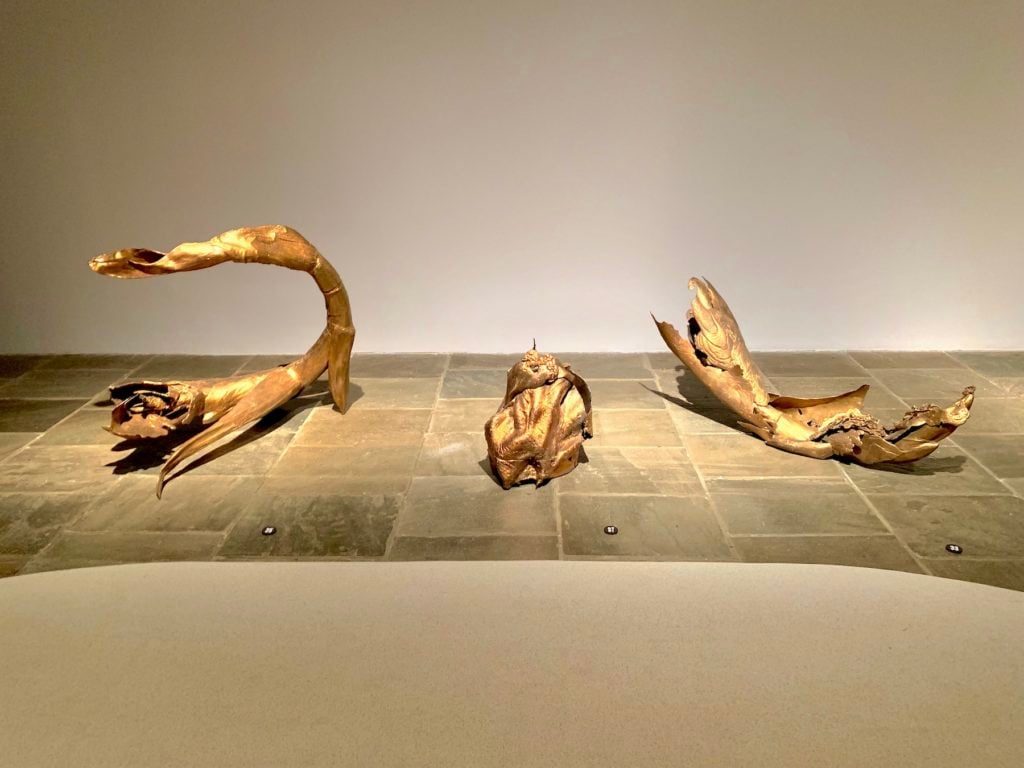
Left to right: Mrinalini Mukherjee’s Palmscape II (2013), Mound III (2009), and Palmscape IV (2013). Image: Ben Davis.
“Phenomenal Nature: Mrinalini Mukherjee” is on view at the Met Breuer, 945 Madison Avenue, New York, June 4–September 29, 2019.